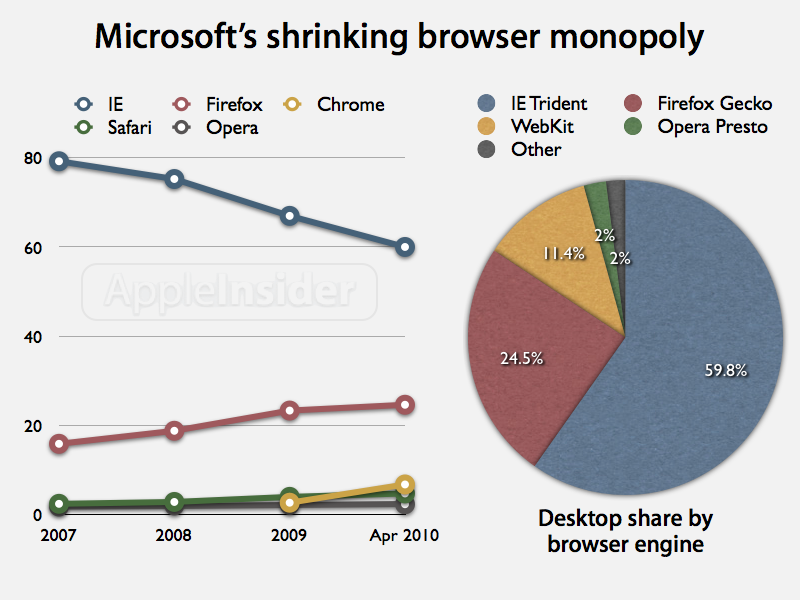Internet Explorer market share drops below 60%
- Transfer
Microsoft’s browser share has fallen to a historic low of less than 60%, the first time since Internet Explorer 4 overcame Netscape’s siege in 1999.
According to statistics released by Net Applications analysts, Internet Explorer’s share fell to 59.95%, dropping from 80 % for 2.5 years.

Under the cut some more statistics and a brief excursion into the history of WebKit
Of the lost 20%, about 9% took Firefox, which now occupies 25%. Another nine went in favor of WebKit-based browsers: 2.5 Safari (it reached 4.72%), while Chrome took 6.7% (from zero in 2009). Opera took another percent for the same period (reaching 2.3%).
Statistics published by StatCounter are even less joyful for Internet Explorer, which accounted for 56.57%, Firefox accounted for 31.29%, followed by Chrome with 5.35%, Safari and 3.63% Opera, 3.63%.

Browser engines
Firefox's Gecko, Oper's Presto, Safari / Chrome's WebKit - these engines are far ahead compared to IE's Trident, which does not support the latest web standards and has not made a breakthrough in JavaScript processing speed like this made by Safari, Chrome and Firefox. The next release of Internet Explorer promises to receive support for key HTML5 features, which will give him hope for a reduction in the fall rate of the occupied share.
None of the browsers is now a commercial product, so vendors must have some other motivation for their development. Microsoft created Internet Explorer to prevent Netscape from entering the market as an alternative to Windows in developing cross-platform applications.
When Netscape was kicked outfrom the market, its developers decided to organize an open-source project Mozilla, whose goal was to continue developing an alternative, uncontrolled Microsoft browser. Firefox development quickly went ahead compared to the development of Internet Explorer, which Microsoft slowed down, having gained a monopoly position in the browser market in 2000.

In 2002, Apple forked KHTML to develop WebCore, a quick and well-composed alternative.Firefox, the legacy of Netscape. WebCore served as the basis for the new Safari browser, which Apple released in 2003, and made available as part of open source. This gave Apple the opportunity to get its own “top-level” browser for Mac (rather than rely on Microsoft or an independent open source project), as well as provide a high-quality, free engine that would help promote the use of open web standards.
Subsequently, in 2005, Apple announced that it would release the entire WebKit engine under open source, and not just WebCore (the part responsible for rendering pages, the heir to KHTML). Nokia immediately released a WebKit-based browser for its S60 platform. In 2007, Apple released Safari versions for Windows and a mobile version for iPhone and iPod touch.
In 2008, Google released Chrome, a WebKit-based browser. The spread of Android, Palm Pre and the upcoming BlackBerry OS 6 update , which includes WebKit browsers, suggests that Apple’s strategy has proven to be a good way to promote open web standards among mobile devices.
via appleinsider.com
According to statistics released by Net Applications analysts, Internet Explorer’s share fell to 59.95%, dropping from 80 % for 2.5 years.

Under the cut some more statistics and a brief excursion into the history of WebKit
Of the lost 20%, about 9% took Firefox, which now occupies 25%. Another nine went in favor of WebKit-based browsers: 2.5 Safari (it reached 4.72%), while Chrome took 6.7% (from zero in 2009). Opera took another percent for the same period (reaching 2.3%).
Statistics published by StatCounter are even less joyful for Internet Explorer, which accounted for 56.57%, Firefox accounted for 31.29%, followed by Chrome with 5.35%, Safari and 3.63% Opera, 3.63%.

Browser engines
Firefox's Gecko, Oper's Presto, Safari / Chrome's WebKit - these engines are far ahead compared to IE's Trident, which does not support the latest web standards and has not made a breakthrough in JavaScript processing speed like this made by Safari, Chrome and Firefox. The next release of Internet Explorer promises to receive support for key HTML5 features, which will give him hope for a reduction in the fall rate of the occupied share.
None of the browsers is now a commercial product, so vendors must have some other motivation for their development. Microsoft created Internet Explorer to prevent Netscape from entering the market as an alternative to Windows in developing cross-platform applications.
When Netscape was kicked outfrom the market, its developers decided to organize an open-source project Mozilla, whose goal was to continue developing an alternative, uncontrolled Microsoft browser. Firefox development quickly went ahead compared to the development of Internet Explorer, which Microsoft slowed down, having gained a monopoly position in the browser market in 2000.

In 2002, Apple forked KHTML to develop WebCore, a quick and well-composed alternative.Firefox, the legacy of Netscape. WebCore served as the basis for the new Safari browser, which Apple released in 2003, and made available as part of open source. This gave Apple the opportunity to get its own “top-level” browser for Mac (rather than rely on Microsoft or an independent open source project), as well as provide a high-quality, free engine that would help promote the use of open web standards.
Subsequently, in 2005, Apple announced that it would release the entire WebKit engine under open source, and not just WebCore (the part responsible for rendering pages, the heir to KHTML). Nokia immediately released a WebKit-based browser for its S60 platform. In 2007, Apple released Safari versions for Windows and a mobile version for iPhone and iPod touch.
In 2008, Google released Chrome, a WebKit-based browser. The spread of Android, Palm Pre and the upcoming BlackBerry OS 6 update , which includes WebKit browsers, suggests that Apple’s strategy has proven to be a good way to promote open web standards among mobile devices.
via appleinsider.com
